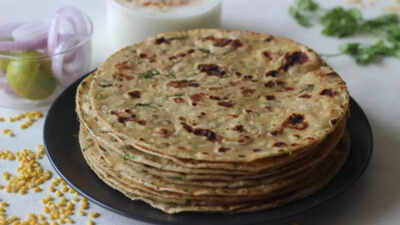Trending
5 types of rotis and their benefits
Roti, a staple Indian flatbread, offers various health benefits depending on the grains used. Popular varieties include whole wheat, bajra, jowar, ragi, and multigrain rotis, each rich in essential nutrients like fibre, iron, calcium, and antioxidants, supporting digestion, heart health, and weight management.

Whole Wheat Roti
The first one of these, and the most common type, is the oldest form found in any Indian homes. It's made from whole wheat flour or atta, which provides nutrient-rich pills loaded with fibre and iron, along with some B vitamins.
Benefits
Weight Management: Due to the high fibre content, whole wheat roti tends to be more filling, thus averting overeating and even helps with weight management.
Lowers the risk of heart diseases: Whole wheat contains antioxidants and other nutrients, which can possibly lower the risk of heart disease by lowering cholesterol levels and improving blood pressure.
Bajra Roti
Bajra roti is pearl millet flour. It is very nutritious and contains adequate magnesium, potassium, and iron and many other beneficial nutrients. These have been integral components of Indian traditional diets for centuries, mainly consumed in winter owing to its warming effect.
Benefits
Gluten-Free: As it is naturally gluten-free, bajra roti becomes an excellent option for those who are suffering from gluten intolerance or celiac disease.
Rich in Iron: Bajra is a good source of iron that prevents anaemia by enriching the blood with haemoglobin.
It Helps Manage Diabetes: Pearl millet has a low glycemic index, and roti prepared from bajra is an excellent option for managing blood sugar levels.

Jowar Roti
Jowar roti is made from nutrient-rich cereal called sorghum flour. It has gained popularity among health-conscious customers because of its high dietary value. Jowar contains dietary fibre, natural antioxidants, and various important vitamins and minerals like calcium and phosphorus.
Benefits
Maintains Healthy Bones: Jowar is rich in calcium and phosphorus, which promotes healthy bones and prevents conditions such as osteoporosis.
It enhances immunity: Antioxidants in jowar builds robust immunity and prevents the body from such infections.
Improves Digestion: Jowar roti contains high fibre, which helps to easily digest the food preventing constipation and boosts the health of gut.
Ragi Roti
Ragi roti is prepared with finger millet flour and is a good source of calcium, iron, and even essential amino acids. Ragi is an easy-to-digest food that is often used in the diets of toddlers and the elderly.
Benefits
Rich in Calcium: Ragi is one among the richest plant-based sources of calcium, thus proving very effective as a food to keep the bones healthy and to prevent all other issues related to the bones, such as arthritis.
Good for Weight Loss: Ragi roti is low in fat and high in fibre, making weight losers feel full for long stretches of time.
Helps Manage Diabetes: Ragi has a low glycemic index meaning it causes sugar to be released into the blood at a slow speed; thus, diabetes patients can consume it.
Multi-Grain Roti
Multigrain roti is prepared from a mixture of different flours such as wheat, oats, barley, and millet. It elevates the nutritional profile of the roti, which thus offers a number of health benefits.
Benefits
Nutrient-Rich: Multigrain rotis comprise a mixture of grains, which implies that every grain contributes differently to the overall nutrition by adding different nutrients like fibre, protein, and essential vitamins and minerals. Therefore, multigrain rotis are extremely nutritious and beneficial for good health.
Metabolism: The grain mix in multigrain roti ensures a healthy improvement of metabolism in the body because they possess a rich content of complex carbohydrates and fibre.
Good for the Heart: Multigrain rotis contain heart-friendly nutrients such as fibre and antioxidants, which can ultimately cut the cholesterol level inside the bloodstream and keep cardiovascular health up to the mark.
Since each type of roti is linked with its specific health benefits, through diet diversified with several types, one can easily achieve a balanced nutritional intake. Whether it is old whole wheat roti or grains like bajra, jowar, or ragi, these rotis go well with any meal and provide all the essential nutrients to cater to specific dietary needs.

About the Author
TOI Lifestyle DeskEnd of Article
FOLLOW US ON SOCIAL MEDIA







